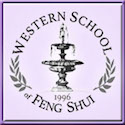Karen Abler Carrasco: Blue has been so heavily associated with water images portrayed in art that it IS challenging to shift our left brain’s training. Many feng shui offerings out there just give up and don’t try. But think about it–When water is painted, it is just reflecting the SKY. It is only blue when the sky is blue. In a lot of art, bodies of water are green, grey, white, brown…the Pacific ocean I see every day is mostly grey or silver, reflecting the clouds and rain. Because water is simply reflecting light, it has no color of its own in real life–it’s an ever-changing mystery. The deeper the water, the further away from light it gets, and it becomes black.
Mid range blues, on the other hand, just do not ACT like Water’s elemental qualities, they act like Wood–in the visible spectrum of light, blue is next to green; in art, the mid ranges of blue do everything with other colors that green does; to our bodies, blue gives us the feelings of upward movement, uplifting our senses to the invigorating feelings of freedom, freshness, hope, inspiration, future. Sky blue just ACTS on our every sense like green growing things do. Picture the green trees stretching up into the blue sky and join the two colors together in that sensation of UP. In contrast, the dark “navy” blues, just like the darker tones of ANY color, sink down to the ground and retreat from us into shadow. The darker they are, the more Water element they depict–deeply mysterious and unfathomable.
These are the Water qualities: A downward movement, into contemplation and infinity, or a brief flash of reflection, like the momentary twinkles of light on the rippling surface of a lake in sunshine. Very different from Wood. Here’s a quick reference guide–pastels of any color are Metal, the paler they are the more Metal they get. Dark tones of any color are Water, the darker they are the more Water. Tints and shades of the colors are always placing themselves somewhere on a spectrum between white Metal and black Water, with the mid ranges holding the fullness of their elements: reds=Fire, oranges=Fire and Earth, yellows and browns=Earth, greens, and blues=Wood, purples=Wood and Fire. Think of the rainbow as showing Fire, Earth and Wood, with black bringing Water and white bringing Metal. After more practice, your own body will start to inform you of the 5 Elements’ qualities, and you will develop an innate feel for analyzing them in any space very quickly.
Comment: I’ve always felt that the easiest to understand explanation is that blue behaves like wood. Put blue against red and see how the wood feeds the fire.

 We recently had a questions about elemental colors- why is blue associated with Wood and not Water? Teacher, Practitioner, and WSFS alum Karen Abler Carrasco explains:
We recently had a questions about elemental colors- why is blue associated with Wood and not Water? Teacher, Practitioner, and WSFS alum Karen Abler Carrasco explains: